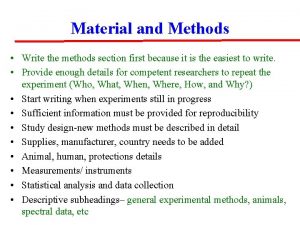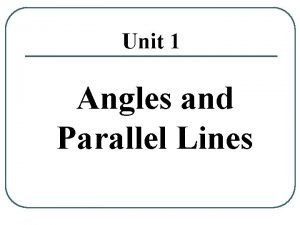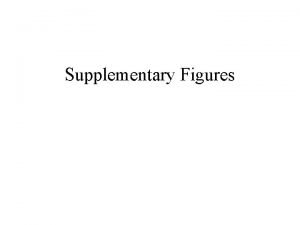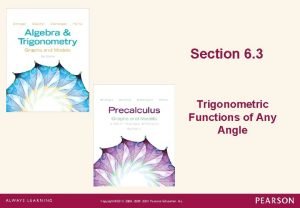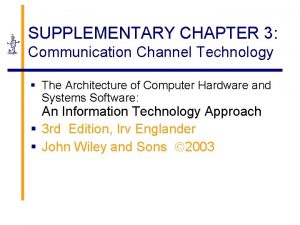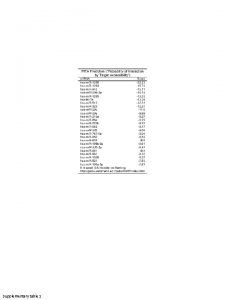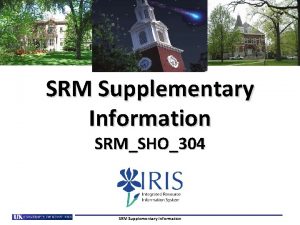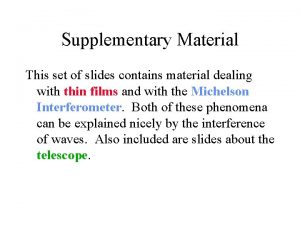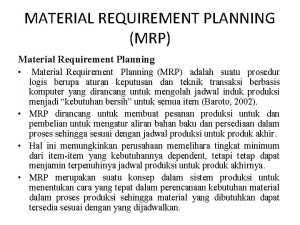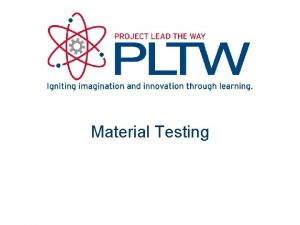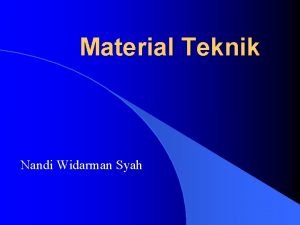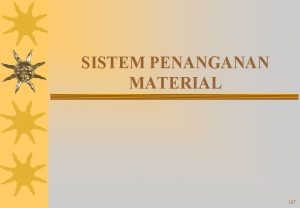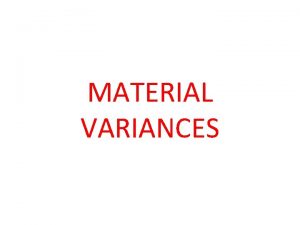SUPPLEMENTARY MATERIAL Krysov et al Supplementary methods Supplementary














- Slides: 14

SUPPLEMENTARY MATERIAL Krysov et al. Supplementary methods Supplementary Tables S 1 and S 2 Supplementary Figures S 1 to S 9

Supplementary methods RNA analysis Total RNA was isolated using the RNeasy kit (QIAGEN, Crawley, UK) according to the manufacturer’s instructions and converted to c. DNA using oligo(d. T) primers and M-MLV reverse transcriptase (Promega, Southampton, UK). For analysis of XBP 1 S RNA we used the approach described previously (Bagratuni et al. 2010). For quantitative PCR (QPCR), PCR reactions were performed using a 7500 Real Time PCR System and Taq. Man Universal PCR Master Mix (Applied Bio. Systems, Warrington, UK) and the following Taq. Man probes: Human B 2 M (beta-2 -microglobulin) endogenous control (4333766 T), XBP 1 (Hs 02856596_m 1), CHOP (Hs 99999172_m 1). Relative RNA quantities were calculated with the equation RQ=2 -(∆∆CT) using B 2 M expression as an internal control and normalized so that the expression in normal B cells, or control CLL cells was set to 1. 0. Published gene expression array (GEA) data (accession: GDS 4176) (Herishanu et al. 2011) were analyzed using the NCBI Gene Expression Omnibus browser (http: //www. ncbi. nlm. nih. gov/geo/). Protein analysis Immunoblotting was performed using the following antibodies: anti-phospho-ERK 1/2 (9101), anti-ERK 1/2 (9102), anti-PERK (5683), anti-BIP (3183), anti-phospho-AKT (S 473) (4060), anti-AKT (9272), anti-phospho-e. IF 2 (S 51) (3597), anti-e. IF 2 (2103) (all from Cell Signaling Technology, Hitchin, UK), anti-XBP 1 (619501; Bio. Legend, London, UK) and anti-β-actin (2066; Sigma-Aldrich, Poole, UK). Secondary horseradish peroxidaseconjugated antibodies were from GE Healthcare (Little Chalfont, UK). Densitometry analysis of immunoblot images was performed using Quantity One software (Bio. Rad). In experiments with longer incubations (>6 hours), cells were treated with the caspase inhibitor z. VADfmk (50 M, Calbiochem) to minimize secondary events due to apoptosis. Immunohistochemical analysis was performed using a tissue-microarray prepared from formalin fixed and paraffin embedded lymph node (LN) tissue sections from 11 cases of CLL/small lymphocytic lymphoma (SLL). Immunostaining was performed on sections after deparaffinisation and citrate buffer (p. H 6. 0) antigen retrieval with anti-XBP 1 (ab 37152; Abcam), anti-PERK (5683; Cell Signaling Technology) or anti-Ki-67 (MIB 1; Dako, Stockport, UK) primary antibodies at a 1: 100 dilution. Diaminobenzidine was used for staining development and the sections were counterstained with Mayer’s haematoxylin. Multiple myeloma sections were used as a staining positive control.

Cell treatments For s. Ig. M stimulation, CLL cells were cultured at 1 x 107/ml and treated with 20 g/m. L soluble goat F(ab')2 anti–human Ig. M (Southern Biotechnology, Cambridge, UK) or goat F(ab')2 anti–human Ig. M coated M-280 Dynabeads (Invitrogen, Paisley, UK). The preparation of anti-Ig. M-coated beads was as described. (Coelho et al. 2013) Cells were treated with antibody-coated beads at a ratio of 2 beads per cell. As controls, cells were treated with soluble or bead-bound, non-immune goat F(ab')2 (Southern Biotechnology). In experiments using chemical inhibitors, cells were pretreated with ibrutinib or tamatinib (both 10 M; Selleckchem, Newmarket, UK) for 1 hour prior to stimulation with anti-Ig. M. Thapsigargin and brefeldin A were from Sigma-Aldrich. Statistics Statistical analyses were performed using Graph. Pad Prism 6 software (Graph. Pad, San Diego, CA, USA). Bagratuni T, Wu P, Gonzalez de Castro D, et al. XBP 1 s levels are implicated in the biology and outcome of myeloma mediating different clinical outcomes to thalidomidebased treatments. Blood. 2010; 116(2): 250 -253. Herishanu Y, Perez-Galan P, Liu D, et al. The lymph node microenvironment promotes B -cell receptor signaling, NF-kappa. B activation, and tumor proliferation in chronic lymphocytic leukemia. Blood. 2011; 117(2): 563 -574.

Sample 154 162 164 170 221 238 255 271 277 279 285 304 305 306 314 315 318 323 324 326 328 329 330 333 341 344 348 350 353 359 361 383 385 391 392 393 394 399 401 402 405 409 410 411 412 420 435 449 459 460 461 462 464 465 469 473 474 475 476 482 489 500 505 518 520 524 Stagea A C A A B C A A A C A A B A A NKd A A A C NK A A A B A C A A NK A A B NK A A A A A B A/B A A A A C A B anti-Ig. M-induced Ca 2+ IGHV mobilization (max. % mutation ZAP 70 c responding cells) statusb 21 U NDd 0 M 39 0 M 1 1 U 26 19 U 16 3 U 82 14 U 25 0 M 31 6 M 0 12 M 0 39 U 35 33 U 24 8 U 65 19 U 23 24 M 1 24 U 15 59 M 2 14 U 67 7 M 1 7 M 8 74 U 16 11 M 0 5 M 66 77 M 1 39 M 0 40 M 31 19 M 0 6 U 63 73 M 2 3 U 1 17 U 5 14 U 17 19 U 11 69 M 6 72 M 3 41 U 96 46 U 25 0 M 21 7 M 14 39 U 57 15 U 77 25 U 8 61 M 0 65 M 2 63 M 1 37 M 1 5 M 45 43 U 6 49 U 23 5 M 11 11 M 8 21 M 0 7 M 30 64 M 2 52 U 53 7 U 86 9 M 45 16 U 51 5 M 9 5 M 2 9 U 62 17 U 14 16 M 1 3 U 76 5 M 3 Table S 1 CD 38 c 38 1 17 100 51 6 8 2 1 0 100 74 9 49 4 8 5 15 0 2 23 93 7 1 80 60 4 95 39 10 98 24 36 1 7 59 96 0 20 99 15 56 56 99 98 100 29 11 44 30 4 3 3 11 4 73 50 1 10 84 1 94 14 0 0 1 a. Binet stage at diagnosis. b. U, unmutated; M, mutated. c% positive cells d. NK, not known; ND, not determined.

Table S 2 Samplea XBP 1 PERK 1 Nuclear expression in ~10% of small cells outside of proliferation centres Extranuclear expression in occasional blasts in proliferation centres Nuclear expression in ~10% of small cells. Occasional positive membrane/cytoplasmic expression in proliferation centre blasts Extranuclear expression in all cells 8 Extranuclear expression in proliferation centre blasts Extranuclear expression in all cells; greater in proliferation centres 9 Extranuclear expression in proliferation centre blasts Extranuclear expression in all cells; greater in proliferation centres 10 Extranuclear expression in proliferation centre blasts; occassional cells with nuclear expression Extranuclear expression in proliferation centre blasts Extranuclear expression in all cells; greater in proliferation centres 12 Negative SUMMARY Infrequent nuclear expression in small cells or extranuclear expression predominantly in proliferation centre blasts Extranuclear expression in all cells; greater in proliferation centres Widely expressed - extranuclear. Often stronger in proliferation centres 2 4 5 6 7 11 Extranuclear expression in all cells in PC and 50% of other cells Extranuclear expression in all cells; greater in proliferation centres Weak extranuclear expression in proliferation centres only a. Cores for sample 3 were missing from the tissue microarray.

Figure S 1 ATF 4 CHOP BIP GADD 34 PERK ATF 6 Phospho e. IF 2 p 50 ATF 6 RNA translation CHOP XBP 1 BIP ERAD IRE 1 XBP 1 Phospho splicing JNK ERAD ER expansion Overview of UPR pathways. The UPR is controlled by three endoplasmic reticulum (ER)resident sensor proteins IRE 1, PERK and ATF 6. ER stress leads to dissociation of the ER chaperone BIP (GRP 78) from these sensors leading to their activation. Full UPR activation is associated with ATF 6 transit to the Golgi where it is proteolytically activated. The resultant 50 k. Da ATF 6 fragment (p 50 ATF 6) is a nuclear transcription factor that induces expression of UPR-associated genes, including BIP, CHOP and XBP 1, and components of the ERAD (endoplasmic reticulum-associated protein degradation) system. IRE 1 undergoes autophosphorylation which activates its endoribonuclease activity resulting in a removal of 26 -base pair fragment from XBP 1 RNA. The XBP 1 splice variant is translated into XBP 1 S, a transcription factor which induces expression of chaperones and ERAD proteins. The UPR is a highly flexible response system and variable activation of its downstream effector arms in different cell types or in response to stimuli of differing strength/duration, fine-tunes responses ranging from survival to apoptosis. Prolonged, high-level UPR responses are linked to cell death which is predominantly mediated by JNK 1, downstream of IRE 1, and, in some cell types, induction of CHOP.

Figure S 2 A B control Time (h): 3 6 24 TG 3 6 24 control 3 6 24 TG 3 6 24 PERK P-e. IF 2 BIP β-actin CLL 500 CLL 489 Regulation of the UPR in thapsigargin-treated CLL cells were treated with thapsigargin (TG; 15 M) or left untreated as a control (Co). Cells were collected after 3, 6 or 24 hours. (A) Q-PCR analysis of CHOP and XBP 1 RNA expression. (B) Immunoblot analysis of PERK, total e. IF 2 , phosphorylated e. IF 2 , BIP and -actin (loading control). Phosphorylated and non-phosphorylated forms of PERK are indicated by white and black triangles, respectively. For (A), CHOP/XBP 1 RNA expression values were normalised to B 2 M expression and normalised expression values of control cells at 6 hours were set to 1. 0. For (B), cells were incubated throughout the experiment in the presence of z. VADfmk (50 m. M) to suppress apoptosis. Data shown were obtained using two samples and are representative of results obtained with 15 samples.

B TG A control Figure S 3 XBP 1 S BACT 277 279 344 353 XBP 1 S BACT XBP 1 S RNA expression in untreated and thapsigargin-treated CLL cells Analysis of full length and spliced XBP 1 RNA in CLL cells using RT-PCR. BACT RNA expression is shown as a control. (A) Representative CLL sample treated with thapsigargin (TG; 15 M). (B) Untreated CLL samples. Data shown are representative of results obtained with 30 different samples.

Figure S 4 A B C D E F Correlations between CHOP and XBP 1 RNA expression and prognostic features of CLL. Correlations between basal CHOP and XBP 1 RNA expression and (A, B) IGHV mutation status, (C, D) CD 38 expression and (E, F) ZAP 70 expression in all samples. The statistical significance of differences was analyzed using the Mann-Whitney test.

Figure S 5 ICsol anti-Ig. Msol 0. 5 1 3 6 8 24 ICbead anti-Ig. Mbead 0. 5 1 3 6 8 24 P-ERK P-AKT -actin Effects of soluble or bead-bound anti-Ig. M on kinase activation CLL samples were stimulated with soluble (sol) or bead-bound anti-Ig. M (anti-Ig. Mbead) or isotype control (IC) antibodies for up to 24 hours in the presence of z. VADfmk. Expression of phosphorylated ERK 1/2 (T 202/Y 204), phosphorylated AKT (S 473) and βactin was analyzed by immunoblotting. Data shown are representative of results obtained with more than 15 samples.

Figure S 6 PERK and BIP expression in control and soluble anti-Ig. M-treated nonresponsive CLL samples. s. Ig. M non-responsive CLL samples (n=4) were incubated with soluble anti-Ig. M for 3, 6 or 24 h and expression of PERK and BIP was analyzed by immunoblotting. Expression values were normalised so that the mean value in control cells at each time point was set to 1. 0. Graphs show mean values (±SD). The statistical significance of the differences between control and anti-Ig. M treated cells are shown for each time point (paired Student’s t-test).

Figure S 7 Comparison of anti-Ig. M-induced PERK/BIP expression and ERK 1/2 phosphorylation in signal responsive samples. Parallel immunoblotting was used to quantify PERK, BIP and ERK 1/2 phosphorylation for 9 of the samples analyzed in Figure 5 of the main manuscript. Expression values were normalized to -actin. We then calculated the expression of each marker in bead-bound-anti-Ig. M treated cells relative to control cells at the same time point. Graphs include comparisons for data for all time points and show results of linear regression and Spearman correlations.

Figure S 8 time (h) control anti-Ig. M 6 24 + - + + PERK BIP -actin PERK and BIP expression in control and anti-Ig. M-treated normal B cells. Normal B cells (anti-CD 138 -depleted) were incubated with soluble anti-Ig. M or isotype control antibody for 6 or 24 h and expression of PERK, BIP and -actin (loading control) was analyzed by immunoblotting. Results are representative of two independent preparations of cells.

Figure S 9 Antigen Anergy “Positive” signaling Strongly downmodulated s. Ig. M responses basal ERK-P Retained s. Ig. M responses basal UPR MCL 1, MYC A model linking differential antigen signaling via s. Ig. M to modulation of the UPR. Antigen signaling results in two predominant signaling responses in CLL; anergy linked to a good prognosis and “positive” growth-promoting signaling linked to more aggressive behavior. BCR-induced UPR activation appears to be linked to positive signaling since basal UPR expression is highest in the subset of samples which retain s. Ig. M signaling responsiveness and is further elevated following treatment with anti-Ig. M in vitro in signal responsive samples.
 Inlay wax pattern fabrication
Inlay wax pattern fabrication Material and methods
Material and methods Gd &t symbols
Gd &t symbols Examples of non material culture
Examples of non material culture Rsq in standard costing
Rsq in standard costing Why are materials useful
Why are materials useful Pop culture sports
Pop culture sports Material and non material culture examples
Material and non material culture examples Llinear pair
Llinear pair Supplementary resources
Supplementary resources Supplementary figures
Supplementary figures Complementary and supplementary angles formula
Complementary and supplementary angles formula Example of supplementary angles
Example of supplementary angles Supplementary means of communication
Supplementary means of communication Developing service products and brands
Developing service products and brands

